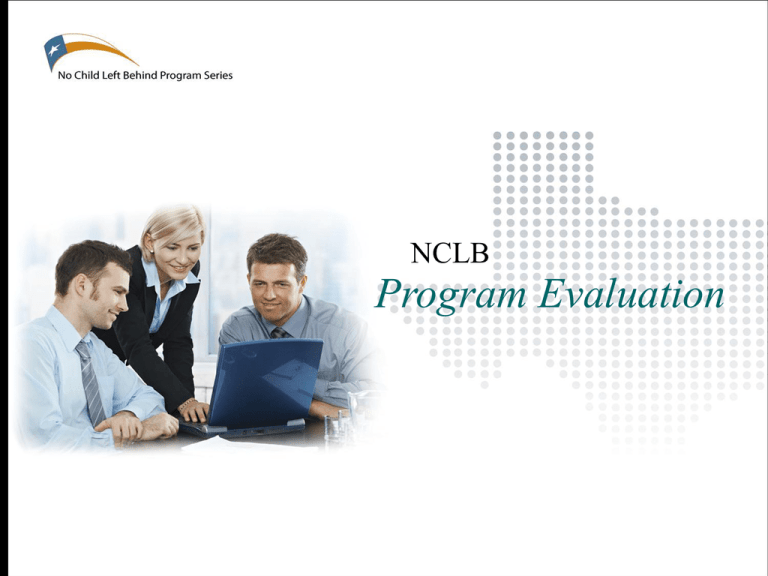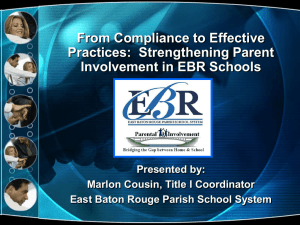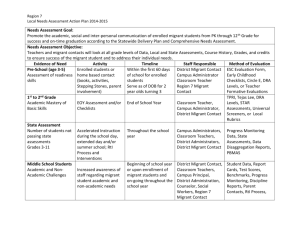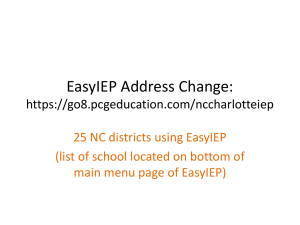Program Evaluation Requirement
advertisement

NCLB Program Evaluation Training Objectives • • To provide consistency across the State regarding a process for conducting program evaluations for NCLB program administration, funding decisions and documentation To provide a resource tool for conducting program evaluation to assess the fidelity of program implementation and impact on student achievement No Child Left Behind Program Series: Program Evaluation A thought… • Well-conceived, well-designed and thoughtfully analyzed evaluations can provide valuable insights into how programs are operating, the extent to which they are serving their intended beneficiaries, their strengths and weaknesses, their cost-effectiveness, and potentially productive directions for the future. Joan Herman Given this, what are the implications for evaluating NCLB programs? No Child Left Behind Program Series Statutory Requirements Program Evaluation Requirement NCLB Funding Application Provision and Assurances The applicant will adopt and use proper methods of administering each such program, including the enforcement of any obligations imposed by law on agencies, institutions, organizations, and other recipients responsible for carrying out each program and the correction of deficiencies in program operations that are identified through audits, monitoring, or evaluation. Title I, Part A The LEA will conduct an annual evaluation of programs assisted with Title I, Part A, funds and will use the findings of this and other evaluations in modifying and improving the program. Evaluation results are to be disaggregated within each LEA and campus by the following: • gender • major racial and ethnic group • English proficiency status • migrant status • students with disabilities as compared to nondisabled students • economically disadvantaged students as compared to students who are not economically disadvantaged. [P.L. 107–110, Section 1111(b)(3)(C)] No Child Left Behind Program Series: Program Evaluation Statutory Requirements Program Evaluation Requirement Title I, Part C The LEA will conduct an annual evaluation of programs assisted with Title I, Part C, funds and will use the findings of this and other evaluations in modifying and improving the program. Data for this evaluation is collected through and available from NGS, the Public Education Information Management System (PEIMS), state assessment answer sheets, regional migrant databases, evaluation reports submitted annually by the district to TEA, and other sources. The LEA or Shared Service Agreement (SSA) fiscal agent will have appropriate consultation with the migrant PAC in planning, reviewing, and improving the local migrant education program. “Appropriate consultation” includes, but is not limited to both of the following: • providing copies of pertinent district and campus improvement plans, state plans, state and federal laws, regulations, and rules; copies of reports resulting from audits, TEA monitoring visits, and complaint investigations; and copies of LEA needs assessments, evaluations, NGS reports, and Standard Application System (SAS) funding applications that describe the academic performance and service needs of migrant students in comparison to other student populations. • empowerment training for PAC members at no cost to parents. The LEA assures that in planning, implementation, and evaluation of the Migrant Education Program, there has been, and will be, adequate provision for addressing the unmet needs of preschool migratory children, as well as, the identification and recruitment of such children. No Child Left Behind Program Series: Program Evaluation Other Program Evaluation Requirements • See pages 2-5. No Child Left Behind Program Series: Program Evaluation Purpose of Tool The purpose of this tool is to provide LEAs and campuses with a systematic process to evaluate the impact of federal program funding. Objectives: • To evaluate the effectiveness and impact of federal programs on student achievement outcomes. • To assess the impact of federally funded strategies on campus performance objectives (CPOs). • To determine the degree to which program funds met the intended purposes. • To guide future program decisions. No Child Left Behind Program Series: Program Evaluation Programs Included in Tool • • • • • • • • • • • Title I, Part A- Improving Basic Programs Parent Involvement Policy and Programs Title I, Part C- Migrant Education Program Title I, Part D2- Prevention and Intervention Programs for Children and Youth Who are Neglected, Delinquent, or At-risk Title II, Part A- Teacher and Principal Training and Recruiting Title II, Part D- Enhancing Education Through Technology Title III, Part A- English Language Acquisition, Language Enhancement, and Academic Achievement Act Title IV, Part A- Safe and Drug Free Schools Title V, Part A- Innovative Programs State Compensatory Education Local Option No Child Left Behind Program Series: Program Evaluation Common Definitions • • • Review Committee: List the committee members involved in the evaluation of this program. Include both names and positions. Identified Needs: What were the identified needs of the organization from the comprehensive needs assessment as they correlate to this program? The district level evaluation should include a review of the reserved funds. Strategies to Address Needs: What strategies were implemented to address the identified need(s) as noted in the district and/or campus improvement plan(s)? No Child Left Behind Program Series: Program Evaluation • • • • Expenditure: What were the total funds from this program used to implement the strategy? (If funds were coordinated with other federal ESEA funds, include only the amount of funds from this source on this worksheet and document the other program on the respective worksheet.) Data: What data was used to measure the fidelity of implementation and the impact? Impact: As you compare the identified needs to the established performance objectives in the district and/or campus improvement plans, what change occurred? Did the activity accomplish what was expected? If yes, why? If no, why not? Recommendations: What are the committee's recommendations to continue, alter, or discontinue the initiative? No Child Left Behind Program Series: Program Evaluation Required Data to Complete Evaluation • • • • Comprehensive Needs Assessment District or Campus Improvement Plan(s) Student Achievement Data Budget Reports No Child Left Behind Program Series: Program Evaluation Added Value Data • • • • • • • • • • • • State Assessment Data TELPAS and AMAO Results PBMAS and DVM reports SAT/ACT/PSAT results Advanced Course/ Dual Enrollment Data Standardized Tests AEIS and AYP Data Tables Completion Rate Promotion/ Retention Rates Evidence of Program Implementation Climate Surveys Demographic Data No Child Left Behind Program Series: Program Evaluation 5-Step Evaluation Process Step 5: Evaluate Impact Step 4: Review Data Step 3: Identify Funds Step 2: Identify Strategies Step 1: List Needs No Child Left Behind Program Series: Program Evaluation Worksheet No Child Left Behind Program Series: Program Evaluation No Child Left Behind Program Series: Program Evaluation Debrief • • How does this tool support our work? What are our next steps? No Child Left Behind Program Series: Program Evaluation Additional Copies? Email: products@esc20.net Posted: www.esc20.net/nclb No Child Left Behind Program Series: Program Evaluation











